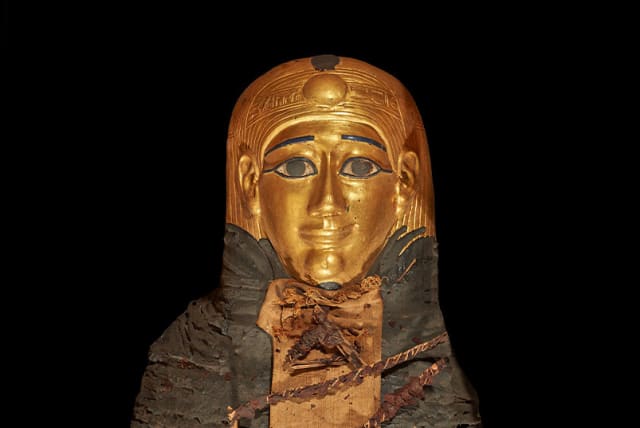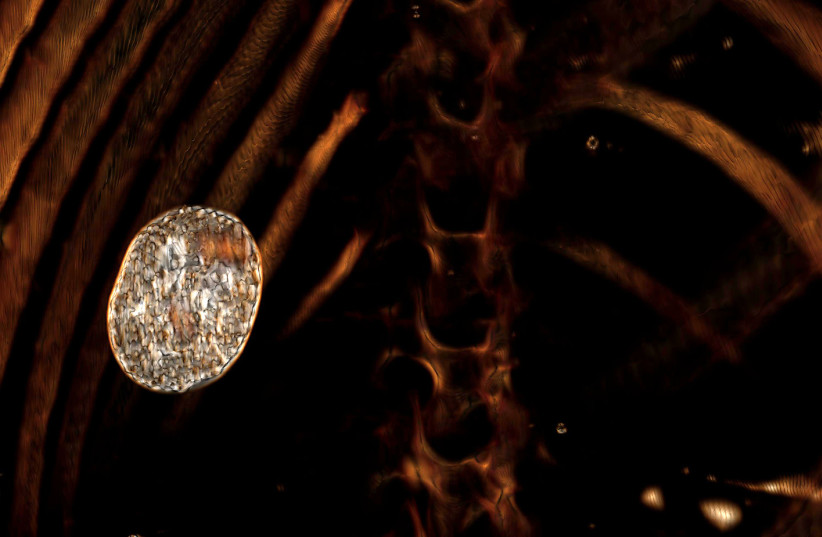2,300-year-old teenage 'golden boy' mummy undergoes CT scan

Close to 50 amulets were found on the body of a 2,300-year-old teenage mummy kept in the Cairo Egyptian Museum.
A 2,300-year-old mummy that was originally found in 1916 but left unexamined, recently underwent CT scans whereby scientists found him wearing 49 ritually-significant amulets and sandals.
The findings of the CT scan have been published in Frontiers in Medicine and were made by a team from the Department of Radiology at Kasr Al Ainy Hospital and the Cairo Egyptian museum.
The amulets and their significance
Following the CT scans, the researchers used 3D printing to enable the tactile and visual study of the amulets, and the result of the 3D CT scanning of the largest amulet in the mummy was translated into a printable format.
Of the 49 amulets found on the ancient mummy, 30 were made of gold or had gold components. Among these amulets were a golden heart scarab placed next to his thoracic cavity, a golden tongue inside his mouth and a two-finger amulet next to his uncircumcised penis.
The remaining 19 amulets were made of stone, fired clay, or Egyptian faience - a ceramic material with a siliceous body and a brightly colored glaze.
The body was also wearing sandals and fern garlands which also hold ritual significance.
The golden scarab was deemed important in the ancient Egyptian belief system, as after death the heart was to be weighed against the goddess Maat's feather. The scarab was thought to silence the heart during judgment day, making the soul more likely to pass through to the afterlife, and act as a substitution for the heart if the organ was ever missing.
Dr. Sahar Saleem, the study’s first author and a professor at the Faculty of Medicine of Cairo University, Egypt., believes that the mummy's sandals "were probably meant to enable the boy to walk out of the coffin. According to the ancient Egyptians’ ritual Book of The Dead, the deceased had to wear white sandals to be pious and clean before reciting its verses."
The golden tongue placed in the mouth was thought to have enabled him to speak in the afterlife. The amulet placed beside his penis was thought to protect the embalming incision.
He also wore an Isis Knot which was believed to enlist the power of the goddess Isis in the protection of the body. Isis was the ancient Egyptian goddess of fertility, motherhood, magic, death, healing, and rebirth
More about the "golden boy"
The boy is thought to have come from a wealthy and powerful family based on the wealth he was buried with. He is thought to have been around 15 at his time of death and his body was found in a cemetery in Neg el-Hassay, Egypt.
The mummy was laid in two coffins. The outer coffin had Greek inscriptions and an inner wooden sarcophagus.
Postmortem, the viscera had been removed through an incision, while the brain had been removed through the nose and replaced with resin. This is commonly found in mummies from this cultural period.
The 'golden boy' mummy is now available for the public to view at the Egyptian Museum, and the researchers generated 2D- and 3D-CT images of the mummy to be used in a short documentary movie that will play alongside the display in the museum showroom. 3D printed objects will also be used for tactile and visual experiences by the visitors.
Jerusalem Post Store
`; document.getElementById("linkPremium").innerHTML = cont; var divWithLink = document.getElementById("premium-link"); if (divWithLink !== null && divWithLink !== 'undefined') { divWithLink.style.border = "solid 1px #cb0f3e"; divWithLink.style.textAlign = "center"; divWithLink.style.marginBottom = "15px"; divWithLink.style.marginTop = "15px"; divWithLink.style.width = "100%"; divWithLink.style.backgroundColor = "#122952"; divWithLink.style.color = "#ffffff"; divWithLink.style.lineHeight = "1.5"; } } (function (v, i) { });


